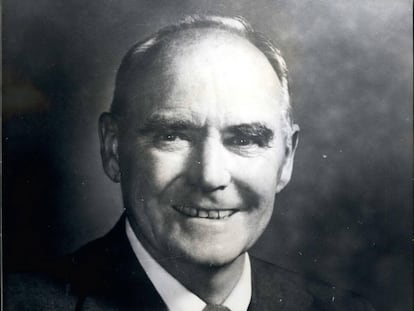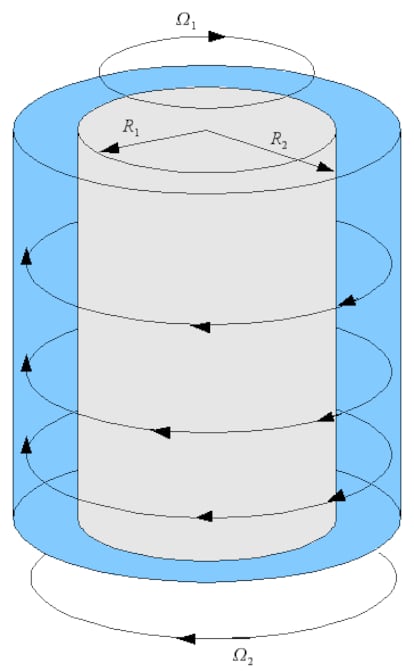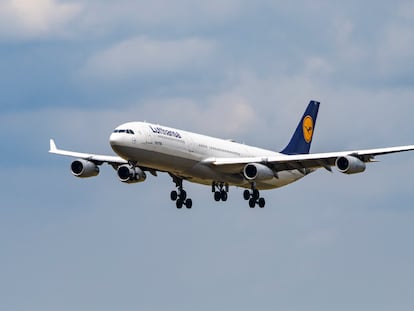Research that changed the dynamic of fluids turns 100
The Taylor-Couette study of flow provides an understanding of the basic principles that govern the behavior of rotating fluids

In 1923 Stability of a viscous liquid contained between two rotating cylinders was published, a revolutionary text written by mathematician and physicist Geoffrey Ingram Taylor (1886, London - 1975, Cambridge). The research on which it was based opened new avenues for understanding the patterns that appear in a flow, such as those observed in the movement of the ocean. A century later, the work continues to provide a solid foundation for a wide range of scientific studies and practical applications. For example, it is key to understanding how turbulence develops from a steady flow, i.e., how one goes from an orderly flow to a chaotic and continuously changing one.
The paper is the beginning of the so-called hydrodynamic stability theory. This branch of physics and mathematics tries to understand instabilities in a fluid, small perturbations that cause the flow to deviate from its initial state and evolve into a different configuration. They are formed, for example, by friction between a moving fluid and a solid surface and can amplify over time to cause noticeable changes in the flow, such as the appearances of vortices or eddies.
For centuries, physicians and mathematicians have tried to find a criterion to detect the moment in which instabilities appear, based on the properties of the fluid and the equations and parameters that describe its motion. Lord Rayleigh’s theory was a first step in resolving this question: it offered a theoretical model to predict the stability of a fluid without viscosity, i.e., one that does not present resistance to flow. In particular, he showed that the flow is stable as long as a certain condition is satisfied — the square of the angular momentum per unit mass of the fluid increases outwards. This means that if only the inner cylinder rotates, the flow is unstable, while if only the outer cylinder rotates, it is stable.
In 1890, physicist Maurice Couette published his doctoral thesis on the friction between a fluid in movement and a solid surface. In order to measure its viscosity, he designed an experimental device formed by two concentric cylinders — one inside, fixed, and the other outside, rotating — with liquid in between. By rotating the outer cylinder, a flow was generated in the fluid and he was able to quantify the friction produced, i.e., its viscosity. His contribution was so important that Couette’s name soon became associated with the flows he studied. At nearly the same time, and independently, Arnulph Mallock, a master of conducting experiments, described the centrifugal instability that occurs when the inner cylinder rotates and the outer cylinder remains stationary.
The next step was to link these experimental observations with Rayleigh’s mathematical formalization. This was precisely what Geoffrey Ingram Taylor did, and he realized that, in the case of non-viscous fluids, the experiments agreed with the theory. Taylor, grandson of the celebrated mathematician George Boole, wrote: “It seems doubtful whether we can expect to understand fully the instability of fluid flow without obtaining a mathematical representation of the motion of a fluid in some particular case in which instability can actually be observed.” Therefore, to begin to understand — using Rayleigh’s mathematical tools — Couette’s flow instabilities, it was essential to find a good example to analyze.
Taylor wondered what could be the result of not only one, but both concentric cylinders rotating. He built such a device and with it, using the mathematical tools, predicted the stability of the fluid. To do this, he linearized the Navier-Stokes equations — which describe the behavior of a fluid. That is, he assumed that the pertubations were small enough to neglect part of the terms in the equation, and found solutions of the equations that correspond to the instabilities observed in the experiments.
The equations allowed him to also determine is instability grew — that is to say, if instable flow can give rise to more complex shapes — or decreases with time — that is, whether the flow will remain stable, unchanged. Thus, Taylor was able to theoretically describe the behavior of the fluid, depending on its properties and the rotational velocities of the two cylinders.

In 1923, he published his work in Philosophical Transactions of the Royal Society. The close agreement between his theoretical and experimental results was unprecedented in the history of fluid mechanics, and as such, the paper is regarded as the first convincing proof of the applicability of mathematical approaches to predict the stability of a fluid.
Taylor’s work connected mathematics, physics and engineering and, in the following years, was used in numerous studies related to stability, astrophysical and geophysical flows, nonlinear dynamics or fundamental aspects of turbulence. Since then, this so-called Taylor-Couette flow has been widely studied and has provided a valuable platform for exploring and understanding the basic principles governing the behavior of rotating fluids.
Jezabel Curbelo is a Ramón y Cajal researcher in the Department of Mathematics at the Universitat Politècnica de Catalunya (UPC) and a member of the Mathematics Institute of the UPC (IMTech) and the Centre de Recerca Matemàtica (CRM).
Ágata Timón García-Longoria is coordinator of the Mathematical Culture Unit of the Institute of Mathematical Sciences (ICMAT).
Sign up for our weekly newsletter to get more English-language news coverage from EL PAÍS USA Edition
Tu suscripción se está usando en otro dispositivo
¿Quieres añadir otro usuario a tu suscripción?
Si continúas leyendo en este dispositivo, no se podrá leer en el otro.
FlechaTu suscripción se está usando en otro dispositivo y solo puedes acceder a EL PAÍS desde un dispositivo a la vez.
Si quieres compartir tu cuenta, cambia tu suscripción a la modalidad Premium, así podrás añadir otro usuario. Cada uno accederá con su propia cuenta de email, lo que os permitirá personalizar vuestra experiencia en EL PAÍS.
¿Tienes una suscripción de empresa? Accede aquí para contratar más cuentas.
En el caso de no saber quién está usando tu cuenta, te recomendamos cambiar tu contraseña aquí.
Si decides continuar compartiendo tu cuenta, este mensaje se mostrará en tu dispositivo y en el de la otra persona que está usando tu cuenta de forma indefinida, afectando a tu experiencia de lectura. Puedes consultar aquí los términos y condiciones de la suscripción digital.
More information
Últimas noticias
More than 40 Democratic lawmakers urge Trump in a letter to stop his ‘attempts to undermine democracy in Brazil’
The journal ‘Science’ criticizes Trump’s anti-renewable energy policy: ‘The US is failing to benefit from its own innovations’
Cubans hope for a miracle as dengue and chikungunya spread
The long shadow of the father figure in the films of Rob Reiner
Most viewed
- Christian Louboutin: ‘Young people don’t want to be like their parents. And if their parents wear sneakers, they’re going to look for something else’
- Cartels in Mexico take a leap forward with narco-drones: ‘It is criminal groups that are leading the innovation race’
- ‘El Limones’ and the growing union disguise of Mexican organized crime
- Liset Menéndez de la Prida, neuroscientist: ‘It’s not normal to constantly seek pleasure; it’s important to be bored, to be calm’
- The low-cost creative revolution: How technology is making art accessible to everyone










































